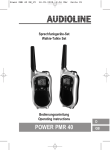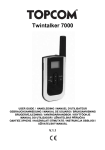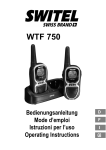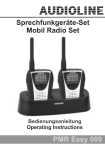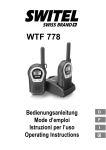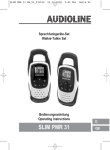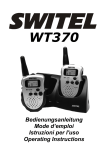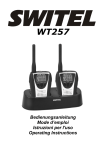Download AUDIOLINE 30 Operating instructions
Transcript
Sprechfunkgeräte−Set Walkie−Talkie Set Bedienungsanleitung Operating Instructions SLIM PMR 30 2 SLIM PMR 30 Bedienungsanleitung . . . . . . . . . . . . . . . . . 3 Operating Instructions . . . . . . . . . . . . . . . 21 1 1 2 3 4 5 6 7 8 Inhaltsverzeichnis Sicherheitshinweise . . . . . . . . . . . 4 Funkgeräte in Betrieb nehmen . . . . 6 Bedienelemente . . . . . . . . . . . . . . 8 Wie bediene ich meine Funkgeräte? 9 Falls es Probleme gibt . . . . . . . . . . 16 Technische Eigenschaften . . . . . . . 17 Pflegehinweise / Garantie . . . . . . . 18 Stichwortverzeichnis . . . . . . . . . . . 19 3 Sicherheitshinweise 1 Sicherheitshinweise Lesen Sie diese Bedienungsanleitung sorgfältig durch. Bestimmungsgemäße Verwendung Diese Sprechfunkgeräte sind geeignet für die Kommunikation mit anderen Sprechfunkgeräten gleichen Standards. Jede andere Verwendung gilt als nicht bestimmungsgemäß. Eigenmächtige Veränderungen oder Umbauten sind nicht zulässig. Öffnen Sie die Geräte in keinem Fall selbst und führen Sie keine eigenen Reparaturversuche durch. Verwendungsbereich Vermeiden Sie Belastungen durch Rauch, Staub, Erschütterungen, Chemikalien, Feuchtigkeit, Hitze oder direkte Sonneneinstrahlung. Verwenden Sie die Funkgeräte nicht in explosionsgefährdeten Bereichen. Netzteil Achtung: Verwenden Sie nur das mitgelieferte Ste− ckernetzteil, da andere Netzteile die Funkgeräte zerstören können. Sie dürfen den Zugang zum Steckernetzteil nicht durch Möbel oder andere Gegenstände versperren. Achtung: Sobald die Stromversorgung hergestellt ist, dürfen die Klinkenstecker weder gegenseitig noch mit anderen Metallgegenständen in Berührung kommen. Medizinische Geräte Achtung: Benutzen Sie die Funkgeräte nicht in der Nähe von medizinischen Geräten. Eine Beeinflussung kann nicht völlig ausgeschlossen werden. Funkgeräte können in Hörgeräten einen unangenehmen Brummton verursachen. 4 Service−Hotline Deutschland: Tel. 0180 5 001388 (Kosten Telekom bei Drucklegung: 14 ct/min) Sicherheitshinweise Entsorgung Sie sind gesetzlich zur sachgerechten Entsorgung von Gebrauchsgütern verpflichtet. Das nebenstehende Symbol bedeutet, dass elektrische und elektronische Altgeräte und Akkus getrennt vom Hausmüll zu entsorgen sind. Elektrische oder elektronische Geräte entsorgen Sie bei einer Sammelstelle eines geeigneten Entsorgungs− trägers. Akkus entsorgen Sie beim batterievertreibenden Handel sowie bei zuständigen Sammelstellen, die entsprechende Behälter bereitstellen. Verpackungsmaterialien entsorgen Sie entsprechend den lokalen Vorschriften. Service−Hotline Deutschland: Tel. 0180 5 001388 (Kosten Telekom bei Drucklegung: 14 ct/min) 5 Funkgeräte in Betrieb nehmen 2 Funkgeräte in Betrieb nehmen Sicherheitshinweise Achtung: Lesen Sie vor der Inbetriebnahme unbedingt die Sicherheitshinweise in Kapitel 1. Verpackungsinhalt prüfen Zum Lieferumfang gehören: − zwei Funkgeräte mit integriertem Akku − eine Doppellade− station − zwei Headsets − ein Netzteil − eine Bedienungsanleitung Funkgeräte aufladen Schließen Sie die Ladestation wie auf der Skizze abgebildet an. Verwenden Sie aus Sicherheitsgründen nur das mitgelieferte Netzteil. Während des Aufladens kann Ihr Funkgerät nicht senden oder empfangen. Stellen Sie den Hauptschalter, an der Unterseite der Funkgeräte, auf ON. Netzsteckdose Laden Sie die Funkgeräte vor der ersten Inbetriebnahme für mindestens 18 Stunden. Wenn Sie die Funkgeräte korrekt angeschlossen haben, leuchten die roten LEDs. Diese erlöschen bei vollständig geladenen Funkgeräten. 6 Service−Hotline Deutschland: Tel. 0180 5 001388 (Kosten Telekom bei Drucklegung: 14 ct/min) Funkgeräte in Betrieb nehmen Laden Sie die Funkgeräte nicht mit fremden Auflade− geräten. Für eine optimale Lebensdauer des Akkus, brechen Sie den Ladevorgang ab, wenn Ihr Funkgerät vollständig geladen ist. Der aktuelle Akkuladezustand wird im Display angezeigt: voll halb schwach leer Sobald die Anzeige im Display blinkt und Warntöne zu hören sind, muss das Funkgerät aufgeladen werden. Funkgeräte direkt aufladen Schließen Sie das Netzteil an die Headset−/Ladebuchse des Funkgeräts an. Verwenden Sie aus Sicherheitsgründen nur das mitgelieferte Netzteil. Während des Aufladens kann Ihr Funkgerät nicht senden oder empfangen. Stellen Sie den Hauptschalter, an der Unterseite der Funkgeräte, auf ON. Netzsteckdose Hinweis: Nur dieses Netzteil verwenden KEAD−237 (DVE−DV−6400UP) Laden Sie niemals gleichzeitig die Funkgeräte mit beiden Lademöglichkeiten. Für eine optimale Lebensdauer des Akkus, trennen Sie die Ladeverbindung, wenn Ihr Funkgerät vollständig geladen ist. Laden Sie die Funkgeräte vor der ersten Inbetriebnahme für mindestens 9 Stunden. Wenn Sie die Funkgeräte korrekt angeschlossen haben, leuchten die roten LEDs. Diese erlöschen bei vollständig geladenen Funkgeräten. Service−Hotline Deutschland: Tel. 0180 5 001388 (Kosten Telekom bei Drucklegung: 14 ct/min) 7 Bedienelemente 3 Bedienelemente Die Merkmale und Funktionen Ihres Funkgeräts sind in den untenstehenden Abbildungen dargestellt. Mobilteil 1 2 3 4 5 6 7 8 9 10 11 12 13 Headset−/Ladebuchse Display Lautstärke + / Einstellung aufwärts Kanalsuche / Monitor Ein / Aus Lautstärke − / Einstellung abwärts Hauptschalter OFF / ON Lautsprecher Menü / Tastensperre Rufton senden Mikrophon PTT−Taste LED Betriebsanzeige 1 13 12 11 2 3 4 10 9 5 6 8 7 Display 1 2 3 4 5 6 7 8 1 Akkukapazität Tastensperre Kanalsuche Bestätigungston CTCSS / CDCSS−Code iVOX−Mode / VOX−Mode Kanal 2 7 3 4 6 5 Service−Hotline Deutschland: Tel. 0180 5 001388 (Kosten Telekom bei Drucklegung: 14 ct/min) Wie bediene ich meine Funkgeräte? 4 Wie bediene ich meine Funkgeräte? Darstellungsweise in der Bedienungsanleitung P a, P b, P Abgebildete Taste drücken Abgebildete Taste lange drücken Abgebildete Taste loslassen [ y ] ð Displayanzeige In das Mikrofon sprechen Ein− / Ausschalten der Funkgeräte 2 An der Unterseite Ihrer Funkgeräte befindet sich der Hauptschalter. Stellen Sie den Schalter auf ON, bevor Sie das Funkgerät einschalten. aV Funkgerät einschalten Es erklingt ein Signal. Im Display werden der zuletzt eingestellte Kanal und die Rufcodierung angezeigt und die Betriebs−LED blinkt. aV Funkgerät ausschalten Sollten Sie das Funkgerät längere Zeit nicht benutzen, empfehlen wir den Hauptschalter auf OFF zu stellen. Nach längerer Zeit werden Kanal und Rufcodierung auf die Werkseinstellungen zurückgesetzt. Lautstärkeregelung X/Y lauter oder leiser (16 Stufen) Senden und Empfangen Senden 3 Wenn Sie die Taste P drücken, leuchtet die Betriebs−LED. Wird die Taste P länger als 60 Sekunden gedrückt, ertönt ein Warnton. Die Übertragung wird unterbrochen. a, P, ð Senden Halten Sie das Funkgerät ca. 5 bis 7 cm vom Mund entfernt und sprechen Sie mit normaler Lautstärke. Um mit anderen Teilnehmern zu sprechen, müssen alle Funkgeräte auf den gleichen Kanal und Rufcodierung eingestellt sein. Service−Hotline Deutschland: Tel. 0180 5 001388 (Kosten Telekom bei Drucklegung: 14 ct/min) 9 Wie bediene ich meine Funkgeräte? Empfangen 4 b, P Empfangen Sie können keine Funksignale empfangen, wenn Sie die Taste P gedrückt halten. Kanalwahl PMR446 (Private Mobil Radio) Funkgeräte können überall in Europa anmelde− und gebührenfrei benutzt werden. Es sind 8 Funkkanäle im Frequenzbereich von 446.000 MHz bis 446.100 MHz freigegeben. 1 x M, X/Y, P Kanal auswählen und bestätigen Kanal Frequenz (MHz) Kanal Frequenz (MHz) 1 2 3 4 446.00625 446.01875 446.03125 446.04375 5 6 7 8 446.05625 446.06875 446.08125 446.09375 CTCSS1/ CDCSS2−Code (Rufcodierungen) wählen Es stehen 38 analoge (CTCSS 1 − 38) und 83 digitale (CDCSS 39 − 121) Codierungen je Kanal zur Verfügung. Funkteilnehmer können nur miteinander kommunizieren, wenn Funkkanal und CTCSS/CDCSS−Code an den Geräten übereinstimmen. Der Kanal und die Rufcodierung werden als nicht hörbares Signal mit der normalen Sprachnachricht mitgesendet. Bei dem Empfänger wird die Sprache nur dann auf den Lautsprecher übertragen, wenn der eingestellte Kanal und die Rufcodierung mit den empfangenen identisch sind. Sollte zufälligerweise auf demselben Kanal ein anderer Teilnehmer dieselbe Rufcodierung verwenden, wechseln Sie bitte mit Ihrem Gespächspartner auf einen anderen freien Kanal. 1 CTCSS: Continous Tone Coded Squelch System = Selektivruf 2 CDCSS: Continous Digital Coded Squelch System = Selektivruf 10 Service−Hotline Deutschland: Tel. 0180 5 001388 (Kosten Telekom bei Drucklegung: 14 ct/min) Wie bediene ich meine Funkgeräte? 2xM X/Y, P Einstellungsmodus aktivieren Rufcodierung auswählen und bestätigen Eine Ausnahme ist die Rufcodierung 0 (Null). Bei dieser Einstellung können, unabhängig von der Ruf− codierung, alle Gespräche auf dem eingestellten Kanal gehört werden. Um am Funkverkehr teilnehmen zu können, müssen Sie dann die gewünschte Rufcodie− rung einstellen. Wenn Sie mit Funkgeräten kommunizieren möchten, die keine Rufcodierung verwenden, müssen Sie an Ihrem Funkgerät die Rufcodierung 0 (Null) auswählen. Kanalsuche In einer Endlosschleife wird auf den acht Kanälen nach Signalen −Symbol angezeigt. Wird ein gesucht. Im Display wird das aktiver Kanal gefunden, stoppt die Kanalsuche. Die Betriebs−LED blinkt einmal pro Sekunde. Drücken Sie die Taste P, um am Funkverkehr teilzunehmen. Wenn Sie die Taste P nicht drükken, wird die Kanalsuche nach fünf Sekunden fortgesetzt. Globale Kanalsuche starten / beenden Stellen Sie die Rufcodierung des Ausgangskanals auf 0 (Null), um die Globale Kanalsuche" durchzuführen. Der Suchlauf stoppt bei jedem Kanal, auf dem ein Signal empfangen wird, unabhängig davon, mit welcher Rufcodierung dieses Signal gesendet wird. N Kanalsuche starten / beenden Der Ausgangskanal ist der Kanal, der beim Aktivieren der Kanalsuche eingestellt ist. Gezielte Kanalsuche starten / beenden Stellen Sie die Rufcodierung von jedem Kanal auf einen individuellen Wert, um die Gezielte Kanalsuche" durchzuführen. Der Suchlauf stoppt nur, wenn ein Signal auf einem Kanal emp− fangen wird, das mit dem eingestellten Wert übereinstimmt. N Kanalsuche starten / beenden Service−Hotline Deutschland: Tel. 0180 5 001388 (Kosten Telekom bei Drucklegung: 14 ct/min) 11 Wie bediene ich meine Funkgeräte? Wenn bei Gezielte Kanalsuche" ein gewünschter Kanal komplett durchsucht werden soll, ist für diesen Kanal die Rufcodierung auf 0 (Null) zu stellen. Kanalsuche fortsetzen X oder Y Kanalsuche fortsetzen Kanal ausschließen 5 Wenn ein gefundener Kanal von der Kanalsuche nicht weiter berücksichtigt werden soll, dann können Sie diesen ausschließen. Halten Sie die Taste X / Y für 3 Sekunden. Beim Start einer neuen Kanalsuche werden wieder alle Kanäle berücksichtigt. a, 3 Sek. X oder Y Kanal wird ausgeschlossen und Kanalsuche wird automatisch fortgesetzt Rufton senden Der Rufton macht andere Teilnehmer darauf aufmerksam, dass Sie ein Gespräch beginnen möchten. Voraussetzung dafür ist, dass die anderen Teilnehmer den gleichen Kanal und Rufcodierung verwenden. T Rufton senden Rufton wählen / ausschalten Sie haben 10 Ruftöne zur Auswahl. Um den Rufton auszuschalten, wählen Sie die Einstellung 0 (Null). 3xM Einstellungsmodus aktivieren X oder Y, P Rufton auswählen und bestätigen Monitor Die Monitor−Funktion ermöglicht es Ihnen, auf dem aktuell eingestellten Kanal nach schwachen Signalen zu suchen. Wenn Sie ein fremdes Signal empfangen, wechseln Sie auf einen freien Kanal. Kommunizieren Sie mit anderen Teilnehmern immer auf einem freien Kanal, um Störungen zu vermeiden. a, N Kanal abhören b, N Abhören beenden 12 Service−Hotline Deutschland: Tel. 0180 5 001388 (Kosten Telekom bei Drucklegung: 14 ct/min) Wie bediene ich meine Funkgeräte? Tastensperre Die Tastensperre verhindert das ungewollte Ändern von Ein− stellungen. Bei eingeschalteter Tastensperre wird das −Symbol im Display angezeigt. Aktivieren 6 a, 3 Sek. M Tastensperre aktivieren Deaktivieren 7 a, 3 Sek. M Tastensperre deaktivieren Bestätigungston Der Bestätigungston erklingt, wenn Sie die Taste P loslassen. Dadurch wird Ihrem Gesprächspartner signalisiert, dass Ihre Übertragung beendet ist. Bestätigungston 8 ein−/ausschalten Schalten Sie das Funkgerät aus. Halten Sie die Taste X gedrückt und schalten Sie gleichzeitig das Funkgerät wieder ein. Bei eingeschaltetem Bestätigungston wird das −Symbol im Display angezeigt. Headset 9 Benutzen Sie das in der Verpackung enthaltene Headset. Stecken Sie das Funkgerät beispielsweise in die Brusttasche, um beide Hände frei zu haben. Da das mitgelieferte Headset über eine zusätzliche P−Taste verfügt, können Sie über diese am Headset senden. Schalten Sie das Sprechfunkgerät aus, bevor Sie ein Headset anschließen. 1. Schalten Sie das Funkgerät aus. 2. Stecken Sie den Stecker des Headsets in die Anschlussbuchse. 3. Schalten Sie das Funkgerät ein. Service−Hotline Deutschland: Tel. 0180 5 001388 (Kosten Telekom bei Drucklegung: 14 ct/min) 13 Wie bediene ich meine Funkgeräte? Automatische Abschaltung Sie können Ihre Funkgeräte so einstellen, dass sie nach Ablauf einer bestimmten Zeit ausgeschaltet werden. Sie können 30, 60 oder 90 Minuten einstellen. Die Funktion ist deaktiviert, wenn Sie die Einstellung 0" ausgewählt haben. 5xM Einstellungsmodus aktivieren X oder Y, P Zeit auswählen und bestätigen VOX1 / iVOX2 (Freisprechen) Bei diesen Funktionen beginnt das Funkgerät automatisch zu senden, wenn Ihre Stimme oder ein Geräusch erkannt wird. Wenn Sie anfangen zu sprechen, tritt eine kurze Verzögerung auf, bevor das Funkgerät sendet. VOX−Modus aktivieren Beim Freisprechen im VOX−Modus wird über ein Headset ge− sprochen. 3 Benutzen Sie ein handelsübliches 2 Headset ohne PTT−Taste mit einem 1 3−poligen 2,5 mm Stereoklinkenste− cker. Steckerbelegung: 1 = Lautsprecher, 2 = Mikrofon, 3 = Masse Schalten Sie das Sprechfunkgerät aus, bevor Sie ein Headset anschließen. Das im Lieferumfang enthaltene Headset ist für diese Funktion nicht ausgelegt, da dieses Headset zusätzlich mit einer PTT−Taste ausgestattet ist. Weitere Informationen finden Sie auf Seite 13. 1. Schalten Sie das Funkgerät aus. 2. Stecken Sie den Stecker eines Headsets in die Anschlussbuchse. 3. Schalten Sie das Funkgerät ein. 4. Im Display wird VOX" angezeigt. 1 VOX: Voice Operated Transmission = Geräuscherkennung 2 iVOX: Intelligent Voice Operated Transmission = Geräusch- erkennung 14 Service−Hotline Deutschland: Tel. 0180 5 001388 (Kosten Telekom bei Drucklegung: 14 ct/min) Wie bediene ich meine Funkgeräte? VOX−Modus deaktivieren Um den VOX−Modus zu deaktivieren, ziehen Sie den Stecker des Headsets aus der Anschlussbuchse oder drücken Sie die Taste P. iVOX−Modus aktivieren Beim Freisprechen im iVOX−Modus wird über das Funkgerät gesprochen. Die P−Taste muss nicht gedrückt werden, um zu senden. 1. Schalten Sie das Funkgerät aus. 2. Halten Sie die Taste P gedrückt und schalten Sie gleichzeitig das Funkgerät wieder ein. 3. Im Display wird iVOX" angezeigt. iVOX−Modus deaktivieren Um den iVOX−Modus zu deaktivieren, schalten Sie das Funkgerät aus und wieder ein. VOX / iVOX−Empfindlichkeit wählen Für den Betrieb im VOX / iVOX−Modus können 3 Empfindlichkeitsstufen entsprechend der Umgebungsgeräusche gewählt werden. Stufe 1 Stufe 2 Stufe 3 laute Umgebungsgeräusche normale Umgebungsgeräusche leise Umgebungsgeräusche 4xM X oder Y, P Einstellungsmodus aktivieren Empfindlichkeit auswählen und bestätigen Service−Hotline Deutschland: Tel. 0180 5 001388 (Kosten Telekom bei Drucklegung: 14 ct/min) 15 Falls es Probleme gibt 5 Falls es Probleme gibt Haben Sie Probleme mit Ihren Funkgeräten, kontrollieren Sie zuerst die folgenden Hinweise. Bei Garantieansprüchen wenden Sie sich an Ihren Fachhändler. Die Garantiezeit beträgt 2 Jahre. Fragen und Antworten 16 Fragen Antworten Keine Funktion − Funkgerät nicht geladen − Tastensperre aktiviert Senden nicht möglich − Taste P zum Senden vollständig drücken − Kanal wird von anderen Teilnehmern benutzt Kein Empfang − Taste P loslassen − Lautstärke zu gering eingestellt − Sie befinden sich außerhalb des Empfangsbereichs, ändern Sie Ihre Position − Hindernisse wie Bäume und Gebäude haben einen negativen Einfluss auf die Reichweite − CTCSS / CDCSS−Code ist nicht identisch mit dem des Gesprächspartners − Kanal wird von anderen Teilnehmern benutzt Service−Hotline Deutschland: Tel. 0180 5 001388 (Kosten Telekom bei Drucklegung: 14 ct/min) Technische Eigenschaften 6 Technische Eigenschaften Technische Daten Merkmal Wert Ausgangsleistung 0.5 W Reichweite Gesamt−Betriebszeit ca. 5 km − bei freier Sichtlinie Bis zu 12 Std. (Basierend auf 5 % Senden, 5 % Empfangen und 90 % Stand−by−Zeit) Max. Gesprächsdauer Bis zu 36 Min. Ladezeit über Doppelladestation Min. 18 Std. Ladezeit über Headset−/Ladebuchse Min. 9 Std. Akku 3,7 V Li−ion Akku, 700 mAh Stromversorgung Eingang: 230 V, 50 Hz Ausgang: 6 V, 200 mA Konformitätserklärung Dieses Gerät erfüllt die Anforderungen der EU−Richtlinie: 1999/5/EG Richtlinie über Funkanlagen und Telekommunikationsendeinrichtungen und die gegenseitige Anerkennung ihrer Konformität. Die Konformität mit der o. a. Richtlinie wird durch das CE−Zeichen auf dem Gerät bestätigt. Für die komplette Konformitätserklärung nutzen Sie bitte den kostenlosen Download von unserer Website www.audioline.de. Service−Hotline Deutschland: Tel. 0180 5 001388 (Kosten Telekom bei Drucklegung: 14 ct/min) 17 Pflegehinweise / Garantie 7 Pflegehinweise / Garantie Pflegehinweise Reinigen Sie die Gehäuseoberflächen mit einem weichen und fusselfreien Tuch. Verwenden Sie keine Reinigungsmittel oder Lösungsmittel. Garantie AUDIOLINE − Geräte werden nach den modernsten Produktionsverfahren hergestellt und geprüft. Ausgesuchte Materialien und hoch entwickelte Technologien sorgen für einwandfreie Funktion und lange Lebensdauer. Die Garantie gilt nicht für die in den Produkten verwendeten Batterien, Akkus oder Akkupacks. Die Garantiezeit beträgt 24 Monate, gerechnet vom Tage des Kaufs. Innerhalb der Garantiezeit werden alle Mängel, die auf Material− oder Herstellungsfehler zurückzuführen sind, kostenlos beseitigt. Der Garantieanspruch erlischt bei Eingriffen durch den Käufer oder durch Dritte. Schäden, die durch unsachgemäße Behandlung oder Bedienung, natürliche Abnutzung, durch falsches Aufstellen oder Aufbewahren, durch unsachgemäßen Anschluss oder Installation sowie durch höhere Gewalt oder sonstige äußere Einflüsse entstehen, fallen nicht unter die Garantieleistung. Wir behalten uns vor, bei Reklamationen die defekten Teile auszubessern, zu ersetzen oder das Gerät auszutauschen. Ausgetauschte Teile oder ausgetauschte Geräte gehen in unser Eigentum über. Schadenersatzansprüche sind ausgeschlossen, soweit sie nicht auf Vorsatz oder grober Fahrlässigkeit des Herstellers beruhen. Sollte Ihr Gerät dennoch einen Defekt innerhalb der Garantiezeit aufweisen, wenden Sie sich bitte unter Vorlage Ihrer Kaufquittung ausschließlich an das Geschäft, in dem Sie Ihr AUDIOLINE − Gerät gekauft haben. Alle Gewährleistungsansprüche nach diesen Bestimmungen sind ausschließlich gegenüber Ihrem Fachhändler geltend zu machen. Nach Ablauf von zwei Jahren nach Kauf und Übergabe unserer Produkte können Gewährleistungsrechte nicht mehr geltend gemacht werden. 18 Service−Hotline Deutschland: Tel. 0180 5 001388 (Kosten Telekom bei Drucklegung: 14 ct/min) Stichwortverzeichnis 8 Stichwortverzeichnis A Aufladen, 6, 7 Ausschalten, 9 Automatische Abschaltung, 14 B Bedienelemente, 8 Bedienung, 9 Bestätigungston, 13 C CTCSS/CDCSS−Code, 10 D Display, 8 E Einführende Informationen, 9 Einschalten, 9 Empfangen, 10 F Fehlerbehebung, 16 Fragen, 16 G Garantie, 18 Gezielte Kanalsuche, 11 Globale Kanalsuche, 11 H Hauptschalter, 6, 7, 9 Headset, 13 I K Kanal ausschließen, 12 Kanalsuche, 11 Kanalwahl, 10 Konformitätserklärung, 17 L Laden, 6, 7 Lautstärkeregelung, 9 M Monitor, 12 P Pflegehinweise, 18 R Rufcodierung, 10 Rufton, 12 S Senden, 9 Sicherheitshinweise, 4 Steckerbelegung, 14 T Tastensperre, 13 Technische Daten, 17 U Umgebungsgeräusche, 15 V Verpackungsinhalt, 6 VOX (Freisprechen), 14 Inbetriebnahme, 6 iVOX (Freisprechen), 14 Service−Hotline Deutschland: Tel. 0180 5 001388 (Kosten Telekom bei Drucklegung: 14 ct/min) 19 Notizen Notizen 20 10 1 2 3 4 5 6 7 8 Contents Safety Information . . . . . . . . . . . . . 22 Putting the Walkie−Talkies into Operation . . . . . . . . . . . . . . . . . 24 Operating Elements . . . . . . . . . . . . 26 Operating the Walkie−Talkies . . . . . 27 In Case of Problems . . . . . . . . . . . 34 Technical Properties . . . . . . . . . . . 35 Maintenance / Guarantee . . . . . . . . 36 Index . . . . . . . . . . . . . . . . . . . . . . 37 21 Safety Information 1 Safety Information Please read this operating instruction manual thoroughly. Intended use These walkie−talkies have been conceived for communication with other walkie−talkies complying to the same standards. Any other use is considered unintended use. Unauthorised modification or reconstruction is not permitted. Under no circumstances open the devices or complete any repair work yourself. Ambient conditions Prevent excessive exposure to smoke, dust, vibration, chemicals, moisture, heat and direct sunlight. Do not use the walkie−talkies in potentially explosive areas. Power adapter plug Attention: Only use the power adapter plug supplied because other power supplies could damage the walkie−talkies. Ensure access to the power adapter plug is not obstructed by furniture or such. Attention: As soon as the power supplied is connected, the jack plugs must not come into contact with each other nor with other metallic objects. Medical equipment Attention: Never use the walkie−talkies in the vicinity of medical equipment. Effects on such equipment cannot be fully ruled out. Walkie−talkies can cause an unpleasant humming sound in hearing aids. 22 Service−Hotline Germany: Tel. 0180 5 001388 (cost via Telekom at time of going to print: 14 ct/min) Safety Information Disposal You are obliged to dispose of consumable goods according to legal requirements. The adjacent symbol indicates that electrical and electronic apparatus and batteries no longer required must be disposed of separate from domestic waste. Electrical and electronic devices must be disposed of at suitable collection points provided by the public waste authorities. Batteries must be disposed of at the point of sale or at the appropriate collection points provided by the public waste authorities. Packaging materials must be disposed of according to local regulations. Service−Hotline Germany: Tel. 0180 5 001388 (cost via Telekom at time of going to print: 14 ct/min) 23 Putting the Walkie−Talkies into Operation 2 Putting the Walkie−Talkies into Operation Safety information Attention: It is essential to read the Safety Information in Chapter 1 before starting up. Checking the package contents The package contains: − two walkie−talkies with integrated batteries − two headsets − an operating manual − a double charging station − a power adapter plug Charging the walkie−talkies Connect the charging station as illustrated in the diagram. For safety reasons, only use the power adapter plug supplied. Your radio will not Transmit / Receive during charging. Set the main switch, located on the underside of the walkie−talkies, to ON. Mains power outlet Before using the walkie−talkies for the first time, charge them for at least 18 hours. When the walkie−talkies are connected correctly, the red LEDs light up. They go out when the walkie−talkies are fully charged. Do not charge the walkie−talkies with charging units from other manufacturers. For optimal battery life, remove the radio from the charger after fully charging. 24 Service−Hotline Germany: Tel. 0180 5 001388 (cost via Telekom at time of going to print: 14 ct/min) Putting the Walkie−Talkies into Operation The current battery charge status is indicated in the display: Full Half empty Low Empty The walkie−talkies need to be recharged as soon as the indicator flashes in the display and acoustic warning signals are issued. Charging the walkie−talkies directly Connect the power adapter plug to the headset/charging socket on the walkie−talkies. For safety reasons, only use the power adapter plug supplied. Your radio will not Transmit / Receive during charging. Set the main switch, located on the underside of the walkie−talkies, to ON. Mains power outlet Note: Use only power supply KEAD−237 (DVE−DV−6400UP) Do not charge the same radio with plug−in charger and drop−in charger simultaneously. For optimal battery life, disconnect the charging connection after fully charging. Before using the walkie−talkies for the first time, charge them for at least 9 hours. When the walkie−talkies are connected correctly, the red LEDs light up. They go out when the walkie−talkie are fully charged. Service−Hotline Germany: Tel. 0180 5 001388 (cost via Telekom at time of going to print: 14 ct/min) 25 Operating Elements 3 Operating Elements The features and functions of the product are depicted in the diagram below. Handset 1 2 3 4 5 6 7 8 9 10 11 12 13 Headset/Charging socket Display Volume + / Increase setting Channel scan / Monitor On / Off Volume − / Decrease setting Main switch OFF / ON Loudspeaker Menu / Key lock Transmit call tones Microphone PTT button LED, indicator 1 13 12 11 2 3 4 10 9 5 6 8 7 Display 1 2 3 4 5 6 7 26 1 Battery capacity Key lock Channel search Confirmation signal CTCSS / CDCSS code iVOX mode / VOX mode Channel 2 7 3 4 6 5 Service−Hotline Germany: Tel. 0180 5 001388 (cost via Telekom at time of going to print: 14 ct/min) Operating the Walkie−Talkies 4 Operating the Walkie−Talkies Display and notation of operating sequences P a, P b, P Press the button depicted Press and hold the button displayed Release the button displayed [ y ] ð Display indicator Speak into the microphone Switching the walkie−talkies on/off 11 The main switch is located on the underside of each walkie− talkie. Set the switch to ON before switching the walkie−talkie on. aV Switch the walkie−talkie on A beep tone is heard. The channel and code used last time will display and the Ready LED flashes. aV Switch the walkie−talkie off If the walkie−talkie is to remain unused for a longer period, we recommend you set the main switch to OFF. If set the switch to OFF for a long time, the channel and code will return to its default setting. Volume control X/Y Raise or lower the volume (16 levels) Transmitting and receiving Transmitting 12 After pressing the P button, the Transmit LED lights up. If the P button is pressed longer than 60 seconds, a warning signal is issued. Transmission is interrupted. a, P, ð Transmit Hold the walkie−talkie approx. 5 to 7 cm from your mouth and speak at a normal volume. In order to talk to other subscribers, the respective walkie−talkies must be set to the same channel and CTCSS/CDCSS codes. Service−Hotline Germany: Tel. 0180 5 001388 (cost via Telekom at time of going to print: 14 ct/min) 27 Operating the Walkie−Talkies Receiving 13 b, P Receive Radio signals cannot be received when the P button is being pressed. Selecting a channel PMR446 (Private Mobile Radio) walkie−talkies can be used throughout Europe free of registration and call charges. There are 8 radio channels available in the frequency range 446.000 MHz to 446.100 MHz. 1 x M, X/Y, P Select the channel and confirm it Channel Frequency (MHz) Channel Frequency (MHz) 1 2 3 4 446.00625 446.01875 446.03125 446.04375 5 6 7 8 446.05625 446.06875 446.08125 446.09375 Selecting the CTCSS1/ CDCSS2 code There are 38 analogue (CTCSS 1 − 38) and 83 digital (CDCSS 39 − 121) codes available per channel. It is only possible to communicate using the walkie−talkies when they are each set to the same channel and CTCSS/CDCSS codes. The channels and the codes are transmitted as inaudible signals together with the standard voice communication. The voice communication is only transferred to the receiving device’s loudspeaker when the channel and the code that it is set on is identical to that received. If another subscriber is coincidentally using the same channel and code, switch to a different, free channel together with the person operating the device called. 1 CTCSS: Continous Tone Coded Squelch System = Selective call 2 CDCSS: Continous Digital Coded Squelch System = Selective call 28 Service−Hotline Germany: Tel. 0180 5 001388 (cost via Telekom at time of going to print: 14 ct/min) Operating the Walkie−Talkies 2xM X/Y, P Activate programming mode Select the code and confirm it An exception here is code 0 (zero). In the case of this setting, all the calls on the set channel can be heard regardless of the CTCSS/CDCSS code. To be able to participate in the radio communication, it may be necessary to set the necessary CTCSS/CDCSS code. If you want to communicate with the walkie−talkies which are not using a CTCSS/CDCSS code, you must select CTCSS/CDCSS code 0" (zero) on your walkie−talkie. Scanning for a channel Signals are searched for in the eight channels in a continuous cycle. The icon appears in the display. If an active channel is detected, the channel scan stops. The Ready LED flashes every second. Press the P button to enable radio communication. If the P button is not pressed, channel scan resumes after five seconds. Start/End global channel scanning To execute a global channel scan", set the CTCSS/CDCSS code of the output channel to 0 (zero). The scanning routine stops at every channel on which a signal is received, regardless of the code transmitted with the signal. N Start/End channel scanning The output channel is the channel which is set when the channel scan is activated. Start/End specific channel scanning To execute a specific channel scan", set the CTCSS/CDCSS code for each channel to an individual value. The scanning routine only stops when a signal is received on a channel that matches the value set. N Start/End channel scanning If a certain channel should be scanned fully during a specific channel scan", the code must be set to 0 (zero) for this channel. Service−Hotline Germany: Tel. 0180 5 001388 (cost via Telekom at time of going to print: 14 ct/min) 29 Operating the Walkie−Talkies Resuming channel scanning X or Y Resume channel scanning Excluding 14 a channel If a channel found during the channel scanning process should not be considered for subsequent use, it can be excluded. All the channels are taken into consideration again when a new channel scan is started. During the time that the walkie−talkie is temporarily stopped on the unwanted channel, press and hold the X / Y for 3 seconds to exclude that channel. a, 3 sec. X or Y The channel is excluded and channel scanning automatically resumed Transmit ringing tone The ringing tones indicate to other subscribers that you want to talk to them. A condition for this is that the other subscribers are using the same channel and CTCSS/CDCSS code. T Send ringing tones Selecting/Deactivating the ringing tone There are 10 ringing tones available for selection. To deactivate the ringing tone, select the setting 0" (zero). 3xM Activate programming mode X or Y, P Select the ringing tone and confirm it Monitor The Monitor function enables the search for weak signals on the channel currently set. If you receive an external signal, switch to a free channel. Always communicate with other subscribers on a free channel to prevent interference. a, N Monitor the channel b, N End the monitoring function 30 Service−Hotline Germany: Tel. 0180 5 001388 (cost via Telekom at time of going to print: 14 ct/min) Operating the Walkie−Talkies Key lock The key lock function prevents inadvertent modification of settings. When the key lock function is activated, the icon appears in the display. Activating 15 a, 3 sec. M Activate the key lock Deactivating 16 a, 3 sec. M Deactivate the key lock Confirmation signal The confirmation signal is issued on releasing the P button. This indicates to the caller that you have ended transmission. Activating/Deactivating 17 the confirmation signal Switch the walkie−talkie off. Press and hold the X button and, while doing so, switch the walkie−talkie on again. icon appears in If the confirmation signal is activated, the the display. Headset 18 Use the headset enclosed with the walkie−talkies. You can put the walkie−talkie in your breast pocket, for example, so that both hands are free. The headset supplied is equipped with an additional P button which can be used to transmit via the headset. Switch the walkie−talkie off before connecting a headset. 1. Switch the walkie−talkie off. 2. Insert the plug on the headset in the connection socket. 3. Switch the walkie−talkie on. Service−Hotline Germany: Tel. 0180 5 001388 (cost via Telekom at time of going to print: 14 ct/min) 31 Operating the Walkie−Talkies Automatic deactivation The walkie−talkies can be set up so that they are automatically switched off after a certain time. It can be set to 30, 60 or 90 minutes. The function is deactivated when the 0" setting is selected. 5xM Activate programming mode X or Y, P Select the time and confirm it VOX1 / iVOX2 (handsfree) When this function is active, the walkie−talkie automatically starts to transmit when the unit detects your voice or a sound. When you start to speak, there is a slight delay before the walkie−talkie starts to transmit. Activating VOX mode When using the handsfree function in VOX mode, conversation is carried out via the headset. 3 Use a commercially available headset without a PTT button equipped with a 1 2 3−pin, 2.5 mm stereo jack plug. Pin assignment: 1 = Loudspeaker, 2 = Microphone, 3 = Earth Switch the walkie−talkie off before connecting a headset. The headset supplied with the walkie−talkie is not designed for this function because it is equipped with a PTT button. Further information is provided on Page 31. 1. Switch the walkie−talkie off. 2. Insert the plug on the headset in the connection socket. 3. Switch the walkie−talkie on. 4. VOX" appears in the display. 1 VOX: Voice Operated Transmission = Noise detection 2 iVOX: Intelligent Voice Operated Transmission = Noise de- tection 32 Service−Hotline Germany: Tel. 0180 5 001388 (cost via Telekom at time of going to print: 14 ct/min) Operating the Walkie−Talkies Deactivating VOX mode To deactivate VOX mode, pull the headset plug out of the connection socket or press the P button. Activating iVOX mode When using the handsfree function in iVOX mode, conversation is carried out via the walkie−talkie. The P button on the walkie−talkie need not be pressed to transmit. 1. Switch the walkie−talkie off. 2. Press and hold the P button and, while doing so, switch the walkie−talkie on again. 3. iVOX" appears in the display. Deactivating iVOX mode In order to deactivate iVOX mode, switch the walkie−talkie off and on again. Selecting VOX / iVOX sensitivity There are three sensitivity levels available for operation in VOX / iVOX mode and can be selected according to the ambient noise. Level 1 Level 2 High ambient noise Normal ambient noise 4xM X or Y, P Level 3 Low ambient noise Activate programming mode Select the sensitivity and confirm it Service−Hotline Germany: Tel. 0180 5 001388 (cost via Telekom at time of going to print: 14 ct/min) 33 In Case of Problems 5 In Case of Problems Should problems arise with the walkie−talkies, please refer to the following information first. In the case of claims under the terms of guarantee, please contact your sales outlet. There is a 2 year period of guarantee. Problems and solutions 34 Problems Solutions Equipment does not function − Walkie−talkie has not been charged − Key lock has been activated Transmission not possible − Press P in fully to transmit − Channel is being used by other subscribers No reception − Release P − Volume setting is too low − You are outside the range of reception, change your position − Obstructions such as trees and build− ings impair the range − CTCSS / CDCSS code set is not identical to that of the other party. − Channel is being used by other subscribers Service−Hotline Germany: Tel. 0180 5 001388 (cost via Telekom at time of going to print: 14 ct/min) Technical Properties 6 Technical Properties Technical data Feature Value Output power 0.5 W Range Total operating time Approx. 5 km in open space Up to 12 h (Based on 5 % transmit, 5 % receive and 90 % standby time) Max. talk time Up to 36 min. Charging time (double charging station) Min. 18 h Charging time (headset/charging socket) Min. 9 h Rechargeable battery 3.7 V Li−ion Battery, 700 mAh Power supply Input: 230 V, 50 Hz Output: 6 V, 200 mA Declaration of Conformity This device fulfils the requirements stipulated in the EU directive: 1999/5/EU directive on radio equipment and telecommunications terminal equipment and the mutual recognition of their conformity. Conformity with the above mentioned directive is confirmed by the CE symbol on the device. To view the complete Declaration of Conformity, please refer to the free download available on our web site www.audioline.de. Service−Hotline Germany: Tel. 0180 5 001388 (cost via Telekom at time of going to print: 14 ct/min) 35 Maintenance / Guarantee 7 Maintenance / Guarantee Maintenance Clean the housing surfaces with a soft, fluff−free cloth. Never use cleaning agents or solvents. Guarantee AUDIOLINE equipment is produced and tested according to the latest production methods. The implementation of carefully chosen materials and highly developed technologies ensure trouble− free functioning and a long service life. The terms of guarantee do not apply to the batteries or power packs used in the products. The period of guarantee is 24 months from the date of purchase. All deficiencies related to material or manufacturing errors within the period of guarantee will be redressed free of charge. Rights to claims under the terms of guarantee are annulled following tampering by the purchaser or third parties. Damage caused as the result of improper handling or operation, normal wear and tear, incorrect positioning or storage, improper connection or installation or Acts of God and other external influences are excluded from the terms of guarantee. In the case of complaints, we reserve the right to repair defect parts, replace them or replace the entire device. Replaced parts or devices become our property. Rights to compensation in the case of damage are excluded where there is no evidence of intent or gross negligence by the manufacturer. If your device shows signs of defect during the period of guarantee, please return it to the sales outlet in which you purchased the AUDIOLINE device together with the purchase receipt. All claims under the terms of guarantee in accordance with this agreement can only be asserted at the sales outlet. No claims under the terms of guarantee can be asserted after a period of two years from the date of purchase and hand−over of the product. 36 Service−Hotline Germany: Tel. 0180 5 001388 (cost via Telekom at time of going to print: 14 ct/min) Index 8 Index A Ambient noise, 33 Automatic deactivation, 32 C Call codes, 28 Charging, 24, 25 Confirmation signal, 31 CTCSS/CDCSS code, 28 D Declaration of Conformity, 35 Display, 26 E Excluding a channel, 30 G Global channel scanning, 29 Guarantee, 36 H Headset, 31 I iVOX (handsfree), 32 K Key lock, 31 M P Package contents, 24 Pin assignment, 32 Preliminary information, 27 Q Questions, 34 R Receiving, 28 Ringing tone, 30 S Safety information, 22 Searching for a channel, 29 Selecting a channel, 28 Specific channel scanning, 29 Starting up, 24 Switching off, 27 Switching on, 27 T Technical data, 35 Transmitting, 27 Troubleshooting, 34 V Volume control, 27 VOX (handsfree), 32 Main switch, 24, 25, 27 Maintenance , 36 Monitor, 30 O Operating elements, 26 Operation, 27 Service−Hotline Germany: Tel. 0180 5 001388 (cost via Telekom at time of going to print: 14 ct/min) 37 Notes Notes 38 Notes Notes 39 Wichtige Garantiehinweise Die Garantiezeit für Ihr AUDIOLINE − Produkt beginnt mit dem Kaufdatum. Ein Garantieanspruch besteht bei Mängeln, die auf Material− oder Herstellungsfehler zurückzuführen sind. Der Garantieanspruch erlischt bei Eingriffen durch den Käufer oder durch Dritte. Schäden, die durch unsachgemäße Behandlung oder Bedienung, natürliche Abnutzung, durch falsches Aufstellen oder Aufbewahren, durch unsachgemäßen Anschluss oder Installation sowie durch höhere Gewalt oder sonstige äußere Einflüsse entstehen, fallen nicht unter die Garantieleistung. BITTE WENDEN SIE SICH IM GARANTIEFALL AUSSCHLIESSLICH AN DEN HÄNDLER, BEI DEM SIE DAS GERÄT GEKAUFT HABEN, UND VERGESSEN SIE NICHT, DEN KAUFBELEG VORZULEGEN. UM UNNÖTIG LANGE WARTEZEITEN ZU VERMEIDEN, SENDEN SIE REKLAMATIONSGERÄTE BITTE NICHT AN UNSERE BÜROADRESSE. BEI FRAGEN ZUR BEDIENUNG UND GARANTIELEISTUNG LESEN SIE BITTE DIE BEDIENUNGSANLEITUNG ODER WENDEN SIE SICH AN UNSERE HOTLINE: 0180 500 13 88 (Kosten Telekom bei Drucklegung: 14 ct/min) AUDIOLINE GmbH Neuss Service−Hotline 0180 500 13 88 (Kosten Telekom bei Drucklegung: 14 ct/min) Internet: www.audioline.de − E−mail: [email protected] Version 1.1 − 16.07.2007









































